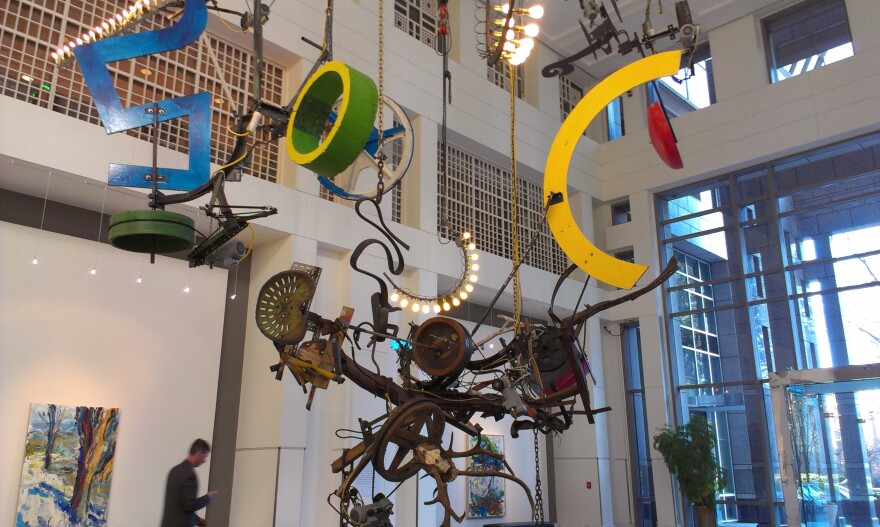Welcome to A Trifling Place, a podcast dedicated to exploring the ins-and-outs of Charlotte.
Overall, Charlotte has more than 100 pieces of public art. In this episode, we’re going to take a tour of a few of them.

For a city of Charlotte's size, we've got a lot of public art. But what qualifies as valuable art is certainly in the eye of the beholder. And when it comes to publicly-funded art, it’s easy to find critics.
During former Charlotte Mayor Pat McCrory's final term in 2009, he asked for less of the ... abstract stuff.
"I'm looking for not all abstract," McCrory says. "But like everything we got presented was pretty abstract, including the garbage can."
One Percent For Public Art
That comment spurred mockery of the city’s public art program by former councilman Andy Dulin:
DULIN: "Could I please make a request to get a $3,500 trash can on the 18 route in front of Myers Park High School where my kids get on and off the bus?"
COUNCIL MEMBER: "Do you want it pastel or primary color?"
DULIN: "I'd like a primary color. One of them pretty ones."
In case you’re wondering, some 12 trash cans with colorful mosaic tiles around them were installed just a few months later in 2009 along Central Avenue by Amy Sanders, a local artist.
Charlotte has had a public art program since 1981, but in 2002, Mecklenburg County adopted a "1% for Art" ordinance, which the city of Charlotte also adopted the following year. So whenever there are new capital investment projects in the city and county – for example, anytime there's a new building being built, major renovations, park or street improvements – one percent of the cost of construction is set aside for public art in those locations.
'Cascade' - Jean Tinguely


Nicole Bartlett, Vice President of Public Art at the Arts & Science Council, occasionally gives tours of Charlotte's public art.
Our first stop is the lobby of the Carillon building in front of Jean Tinguely's Cascade.
He was married to Niki De SaintePhalle, the French sculptor who created the Firebird, one of Charlotte's most iconic pieces in front of the Bechtler Museum.
In 1989, Tinguely began working on the Cascade -- a moving sculpture made up of kinetic, motorized pieces. If you look closely, you'll find antlers, chain links, light bulbs and even the hood of a Ferrari suspended 40 feet above an indoor fountain.
"All of the pieces kind of arrived on site bit by bit and each day pieces would come and he would pick pieces to put into the sculpture," Bartlett says. "Here you can see a lion's head, which once was on the façade of the historic Hotel Charlotte that sat on this site."
It moves with the help of 15 motors. This was Jean Tinguely's last major project before he died in 1991.
'Il Grande Disco' - Arnaldo Pomodoro
The intersection of Trade and Tryon (Independence Square) is known for four landmark statues by Raymond Kaskey.
But behind the statues is a golden disc by Italian sculptor Arnaldo Pomodoro.

On the ground, you'll find this plaque dated October 2, 1974:
GRANDE DISCO Our life today is one of crisis...of movement... of tension. We do not know what our world will become. I try to say something about this uncertainty in my work. I try to communicate a sense of vitality and connection with the movement of life today... And to be a part of its movement. The social challenge of art today, in my opinion, is to start a dialogue with the people. I hope that is what happens here with The Grande Disco.
"Il Grande Disco" has been stationary for at least 20 years. But it's been there since 1974, when Bank of America Plaza was completed.

I thought the piece had to do with commerce or the circle of life, but I was totally off …
Part of the fun of public art is thinking about what it means to you. You don't necessarily need to know all of the details. But just figuring out what that signifies to you and then the fun of going to find out what it really means - Nicole Bartlett
'Touch My Building' - Christopher Janney

And our last stop was in front of what's probably the most interactive piece of public art in Charlotte. It's called Touch My Building by Christopher Janney. It's on the exterior of the Seventh Street parking garage in uptown – it's made out of blue and purple transparent plexiglass rectangles – with 30-feet tall red strips in between featuring touch panels with audio speakers next to it. When you high five the panels, you get random melodies.
Christopher Janney calls it an "urban musical instrument".
"The idea is that to transform the building into a giant music box to allow people to literally people to play with the architecture," Janney says.
And at the top of every hour, a "ghost" triggers the piece to play by itself. Janney says the ghost refers to the computers in his installations and lets the piece carry on a conversation with people who are walking by.
And if you have a little bit of time while you're walking through or waiting for the train and want a challenge – make sure to look for a 10 inch plaque on the side of the building. It contains a poem with a riddle. If you solve the riddle and hit the panels in the right sequence, the pieces on the building light up.

Janney says one of the goals of the piece is to act as a social foil.
"It encourages people to interact with one another, especially in an urban environment where we all live pretty densely packed and yet we don't seem to relate to one another," Janney says.




